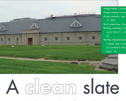Many roofing-related hazards such as falls, cuts from sharp tools and burns from hot asphalt are easily recognizable. But there is a hazard that is not so easy to spot: silica dust.
Silica is present in concrete, roof tiles and other construction materials that have sand as a component. When these materials are cut, silica dust is released into the air. And when inhaled at significant levels during a prolonged time period, silica dust can cause silicosis, an incurable, progressive lung disease that can be fatal.
Silicosis causes scar tissue to form in the lungs, which reduces the lungs' ability to extract oxygen from the air. According to the National Institute for Occupational Safety and Health, 200 construction workers die from silicosis each year.
A brief history
Overexposure to silica dust is not a new hazard. The first comprehensive study of occupational health hazards, De Morbis Artificum Diatriba (Diseases of Workers), was conducted by 17th century Italian physician Bernardino Ramazzini, who studied the effects of chemical-, metal- and dust-related health hazards on workers from 52 occupations. One thing Ramazzini noted among stonecutters was a sand-like substance present in their lungs.
Currently, silica is found in a wider variety of building materials. There are two basic types: amorphous silica, which is found in glass, and crystalline silica.
Crystalline silica is found in cristobalite, tridymite and quartz. Quartz is present in sand, and because concrete is partly composed of sand, roofing workers who cut concrete tiles or roofing pavers are vulnerable to inhaling silica dust.
Similarly, most clay roofing tiles contain sand, and when workers dry-cut these types of roofing tiles using gas-powered or electrically powered cutters, silica dust is released.
Silicosis' symptoms may include shortness of breath, fatigue, severe cough and chest pain.
Precautions
You should check for the presence of silicon dioxide in the concrete or clay roofing materials you use. One way to do so is to refer to material safety data sheets (MSDSs) that come with concrete or other tiles for silicon dioxide. The Occupational Safety and Health Administration (OSHA) requires that you train your workers to understand MSDSs, as well.
You also can determine how serious a silica hazard is at a job site by using special equipment to monitor the air.
The most effective way to protect workers from exposure to silica dust is to have them wear N-95 or more protective respirators. But OSHA requires that workers receive proper respirator training.
According to OSHA 29 CFR 1910.134, employers must establish a written respiratory protection program if their employees wear respirators. The program must include procedures for selecting respirators, medical evaluations of workers who wear respirators, fit-testing procedures for respirators, procedures for proper respirator use, procedures for cleaning and maintaining respirators, procedures for ensuring air quality and quantity, training employees in respiratory hazards and respirator use, and evaluation of the respiratory protection program's effectiveness.
Additionally, in 1996, OSHA published a Special Emphasis Program on Silica outlining the sampling methods and medical screening protocol required at any job site where workers are exposed to respirable silica beyond the permissible exposure limit (PEL). States may have their own standards that are more stringent than OSHA's construction standard PEL.
Protect employees
Ramazzini was dedicated to workers' health problems. If he were alive today, he certainly would be gratified to learn exposure to silica dust and silicosis are being treated seriously. Make sure you are aware of this hazard, and take the necessary precautions to protect your employees.
Peter Greenbaum is NRCA's director of education and training media.



